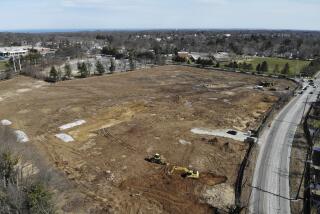In Russia, the Suburbs Are Coming
- Share via
MOSCOW — The cookie-cutter townhouses feature five bedrooms and wall-to-wall carpeting. Polished station wagons fill two-car garages along the quiet cul-de-sacs. Kids roam manicured lawns dotted with picnic tables and barbecue grills.
Of the countless imports that have flowed into Russia in recent years, this is surely one of the strangest--an entire American suburb.
Carved out of a pine forest on the northwestern fringe of the Russian capital, the Rosinka subdivision is an American-style planned community of 200 townhouses that rent for $73,000 to $115,000 a year.
That is a stunning sum for the people of a city where the average worker earns the equivalent of about $7,500 a year.
But there is a six-month waiting list to get in, said Peter Startsev, deputy general manager of the private, gated community, which caters mostly to Western businessmen and their families.
“I love it here. The grass and the hills are always speckled with dogs and children. The people are so friendly,” said Mary Keith, an American who arrived from Hawaii 18 months ago with her husband, Lew, a mechanical engineer on a two-year contract.
“I was worried about going from Maui to Moscow,” she added. “But I like living here so much I told my husband I’m going to defect.”
The two-story townhouses, which are comfortable but not luxurious, have three to five bedrooms and come in two basic models--gray-and-white paneling or red brick.
They don’t just resemble suburban American homes. Most are 100% American.
Designed by U.S. architects, the first houses were built five years ago entirely with imported bricks, lumber and plumbing and they were fitted with American furnishings down to the Frigidaires in the kitchens.
Builders now use a few local materials, such as Russian tile, but most items still come from the United States.
Rosinka’s residents also live relatively close to the Moscow Country Club, which features Russia’s only 18-hole golf course, a big draw for some of the foreigners.
Russia, the land of the cramped apartment, has always suffered from a lack of decent housing. Soviet authorities left their mark with endless high-rise apartment buildings that resemble public housing in America’s inner cities.
The Soviet breakup and the influx of Western businessmen created a small, though expanding market for bigger houses.
Rosinka, the first and largest of several American-style suburban developments, plans another 200 townhouses on the 125-acre site about 15 miles northwest of the Kremlin.
To the south of Moscow, the first six of 90 upscale, detached homes have risen this year in Pine Forest, a planned community developed by Canadian builder Robert Elensky.
A Houston-based company, Hines, has broken ground on a $130-million suburb in northwest Moscow that will have 260 townhouses, with the first ready for occupancy in about a year. The community will also have its own supermarket, school and sports facilities.
When the Hines deal was announced in March, city officials billed it as the “largest land transaction in the history of Moscow.”
So far, most suburbanites are businessmen from the United States and western Europe, and their companies are paying the sky-high rents.
But there is also a smattering of wealthy “new Russians,” mostly bankers who covet security in a country where rich businessman have been frequently targeted for attack by gangsters. Pine Forest and Rosinka both have perimeter fences and guards who check everyone entering the subdivisions.
“We are trying to understand the housing trends, but they are not very clear right now,” said Startsev, the Rosinka developer. “Still, we think the possibility of a Russian middle class is growing.”
Better-off Russians have long had dachas, or country homes, for weekend use, but the notion of full-time suburban living was an alien concept until Westerners started pouring in.
As the private property market expands, rich Russians are building huge, extravagant houses in dacha country, often in jarring contrast to the traditional, gingerbread-style wooden dachas that often lack running water and indoor plumbing.
But overall, Russians “are still not comfortable with the idea of suburbia,” said Maria Elensky, who leases the houses her husband builds in Pine Forest.
“They still think this is dacha country,” Mrs. Elensky said of the development on the grounds of a former presidential retreat 20 miles south of central Moscow.
Russians are also dubious of wood-frame houses and high-tech insulation that is much more streamlined than the thick walls they consider essential for winter survival.
Mrs. Elensky said it is difficult to persuade skeptical Russians that such houses, built with materials from Canada, have endured many a snowstorm in her homeland.
“Russians think wood-frame houses will just blow over,” she said. “If they can put a hole in a wall with a nail, they’re worried.”
More to Read
Sign up for Essential California
The most important California stories and recommendations in your inbox every morning.
You may occasionally receive promotional content from the Los Angeles Times.










